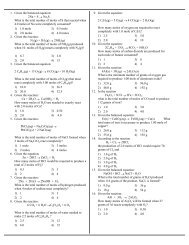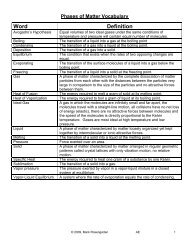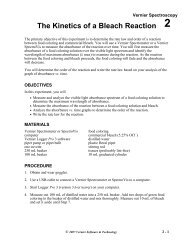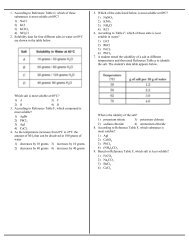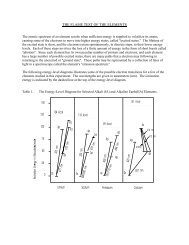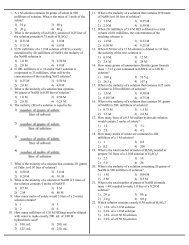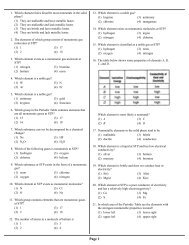Kinetics, Thermodynamics and Equilibrium - Revsworld
Kinetics, Thermodynamics and Equilibrium - Revsworld
Kinetics, Thermodynamics and Equilibrium - Revsworld
You also want an ePaper? Increase the reach of your titles
YUMPU automatically turns print PDFs into web optimized ePapers that Google loves.
Going up the down escalator: This diagram shows different points at which a system can reach equilibrium:<br />
TYPES OF EQUILIBRIUM<br />
1) Chemical <strong>Equilibrium</strong>: The rate of the forward reaction is equal to the rate of the reverse reaction.<br />
The Haber Process: used to manufacture ammonia. Why ammonia? To make lots of different cleaning products.<br />
This is a multi-billion dollar industry, all based on this simple equilibrium:<br />
N 2 (g) + 3 H 2 (g) 2 NH 3 (g) + heat<br />
This reaction produces ammonia, but some of the ammonia decomposes to form its original elements. When the rate<br />
of synthesis equals the rate of decomposition, this system will be at equilibrium. It is possible to apply stresses to this<br />
equilibrium to force it to produce more ammonia.<br />
The ratio of amount of product to the amount of reactant at equilibrium is called the EQUILIBRIUM CONSTANT. It is a<br />
number that represents how far the reaction went before reaching equilibrium.<br />
K eq = [products] / [reactants], where [ ] st<strong>and</strong>s for concentration.<br />
Mass Action Expression: a ratio of the concentration of the products to the concentration of the reactants. Used to<br />
determine the degree to which the forward reaction proceeded before equilibrium was established.<br />
aA + bB cC + dD, where the lower case letters represent the coefficients of the substances in the reaction<br />
[C] c [D] d<br />
K eq = ---------<br />
[A] a [B] b<br />
Products over reactants, coefficients become exponents, concentrations are multiplied<br />
© 2009, Mark Rosengarten AE 10






